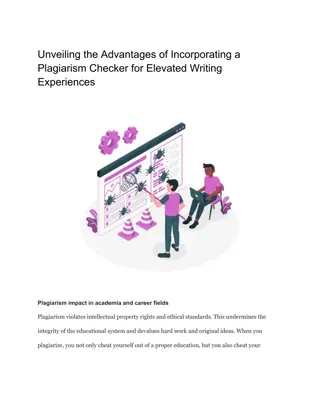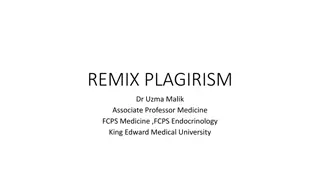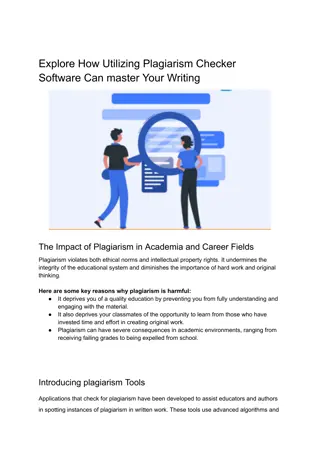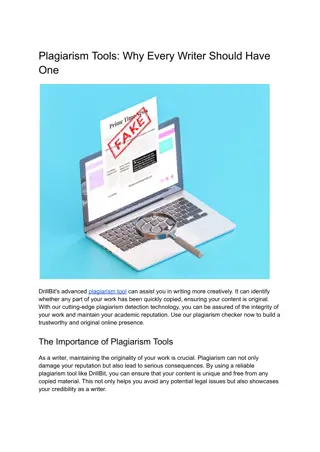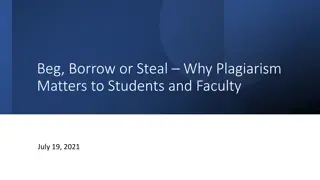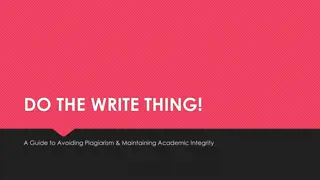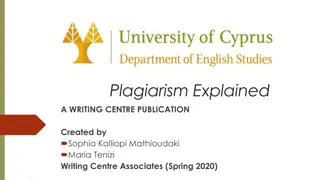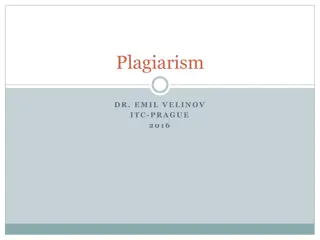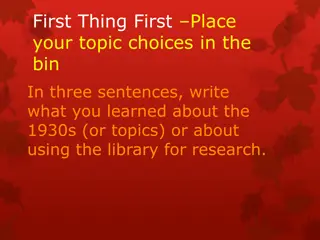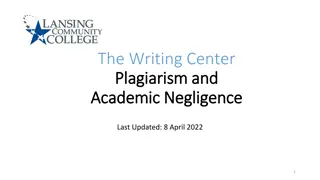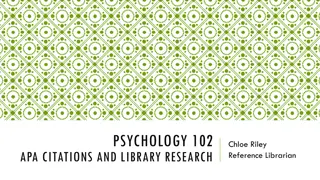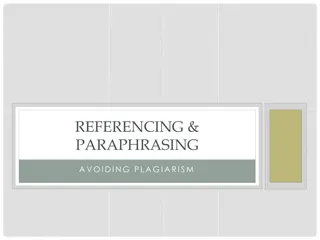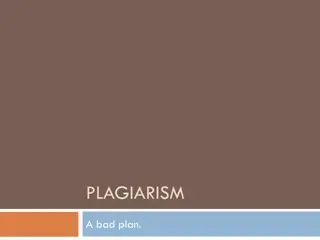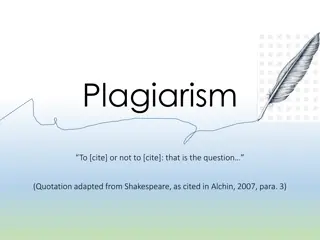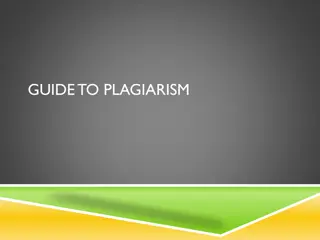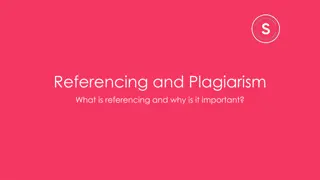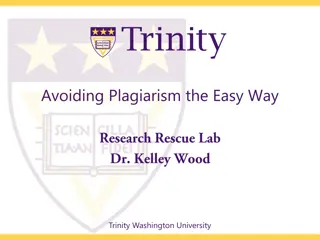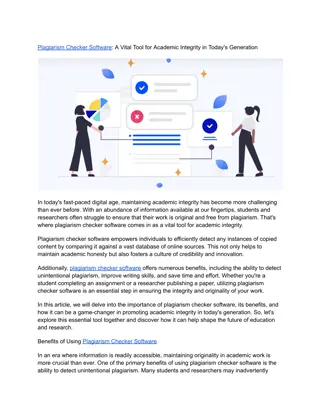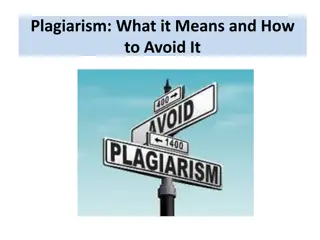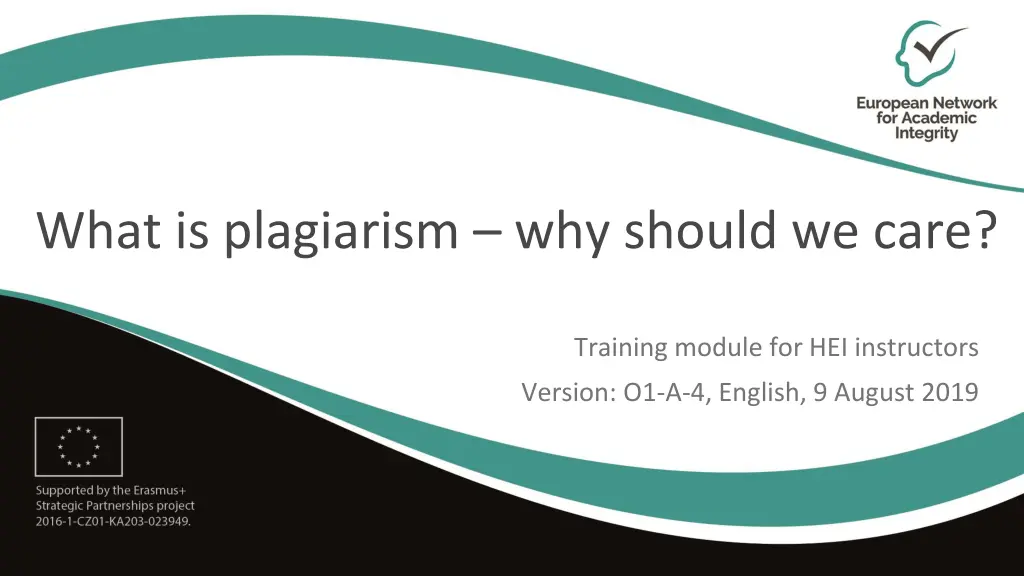
Understanding Plagiarism and Its Impact
Explore the definition of plagiarism, reasons for its importance, and educational approaches for addressing it. Learn how to identify and prevent plagiarism while navigating grey-area scenarios. Discover the significance of acknowledging sources to uphold academic integrity.
Download Presentation

Please find below an Image/Link to download the presentation.
The content on the website is provided AS IS for your information and personal use only. It may not be sold, licensed, or shared on other websites without obtaining consent from the author. If you encounter any issues during the download, it is possible that the publisher has removed the file from their server.
You are allowed to download the files provided on this website for personal or commercial use, subject to the condition that they are used lawfully. All files are the property of their respective owners.
The content on the website is provided AS IS for your information and personal use only. It may not be sold, licensed, or shared on other websites without obtaining consent from the author.
E N D
Presentation Transcript
What is plagiarism why should we care? Training module for HEI instructors Version: O1-A-4, English, 9 August 2019
Basic information for trainers Target group of HEI instructors: any beginner or advanced instructors Instructors for (under-)graduate, PhD and other levels, teaching assistants other staff at HEI Summary of content: definition of plagiarism, reasons for good practice and referencing, suggestions for educational approaches, related grey- zone phenomena Learning objective(s): tell definition of plagiarism, assess its possible educational use, develop own approach to teach it, discover related controversial grey-zone phenomena 27/06/2025 Training module: Definition(s) of plagiarism 2
Basic information for trainers Educational formats: presentation, discussion, feedback Duration: up to 120 minutes (depending on your final design and amount of activities) Recommended number of participants: unlimited Please look for comments in slide notes for further instructions and hints. 27/06/2025 Training module: Definition(s) of plagiarism 3
Basic information Learning objectives: Tell definition of plagiarism, explain meaning of terms Illustrate reasons for good practice Discover related grey-zone phenomena Develop own approach to teach about it Educational formats: presentation, discussion, feedback Duration: 90 minutes 27/06/2025 Training module: Definition(s) of plagiarism 4
What is plagiarism? Many definitions Usefulness of each definition differs depending on context (e. g. economic, artistic, scientific,...) objective (e. g. educational, informative, assessment) 27/06/2025 Training module: Definition(s) of plagiarism 5
Definition from ENAI-Glossary Plagiarism is: Presenting work / ideas taken from other sources without proper acknowledgement. Adapted for ENAI-Glossary from: Meuschke, N., & Gipp, B. (2013). State- of-the-art in detecting academic plagiarism. International Journal for Educational Integrity, 9(1): 50-57) 27/06/2025 Training module: Definition(s) of plagiarism 6
In detail work / ideas apply to all kinds of extracts or content used e. g. characteristic formulation, content of text, newly introduced terms, data, graphics, images, models, hypotheses, lines of argument, program code, technical drawings, specifically developed methods,... 27/06/2025 Training module: Definition(s) of plagiarism 7
In detail proper acknowledgement means the obligation to clearly mark all used content regardless how you have used it e. g. in full or in part, identically or modified, verbatim quotation, paraphrased or translated text. regardless of the type of source e. g. from a journal article, website, book, conference paper, primary source, secondary literature, data repository, 27/06/2025 Training module: Definition(s) of plagiarism 8
Activity: Reasons for referencing Please work together and collect in groups of 4-5 people (10 minutes): Why do you as a reader expect citations or references in texts by other researchers or students? Do you have specific reasons or examples related to your subject, why referencing is important? Please decide within the group: What might be the most convincing reason for the audience you teach? Your suggestions will be shared with the plenary. 27/06/2025 Training module: Definition(s) of plagiarism 9
Activity: Reasons for referencing Please work together and draft an answer in groups of 4-5 people (10 minutes): What would you answer a student who expresses an opinion like that: Why should I reference properly and not copy-paste? It is correct, what I am writing, my later job is not at all related to scientific working, so I do not need to know how to do it, and also referencing is quite a petty activity. Your suggestions will be shared with the plenary. 27/06/2025 Training module: Definition(s) of plagiarism 10
Explore and talk about Why? For students it is essential to explore, discover and thus understand, why referencing is required in academic work. In other words: why they should comply with professional working standards. Suggestions: Create tasks, examples, situations, where they can learn about why? . Give meaning to learning. Raise motivation. 27/06/2025 Training module: Definition(s) of plagiarism 11
(Most?) Important reason In science, research, and other academic work the possibility to trace back sources and reproduce work results are the most important features. Therefore, references are needed to review and challenge the line of argument and results. 27/06/2025 Training module: Definition(s) of plagiarism 12
Very convincing reason for students Give them that one! Clarify responsibilities for work, data, results, etc. References guarantee transparency, who is accountable for what. If you use content without a reference, the reader would assume, that you are the author of the content or results and hold you responsible. By giving a reference, you can easily protect yourself from mistakes by others, which your work may rely on. 27/06/2025 Training module: Definition(s) of plagiarism 13
Pragmatic reason for students Prove your skills. To demonstrate referencing skills is required for exams. By researching and referencing work of others, you show the ability to find and use results of others. That contributes to your work and success. 27/06/2025 Training module: Definition(s) of plagiarism 14
Activity: What do you think? Choose and discuss in groups of 4-5 people one of the following topics (15 minutes): Is there something like self-plagiarism? Is it plagiarism? Does it apply for students or only scholars? What about accidental or careless plagiarism: is it plagiarism or not? Does plagiarism need to be intentional to be plagiarism? Is so-called honour, gift or principal investigator authorship, which is not based on a substantial contribution to the work, plagiarism? Share a conclusion of your group discussion with the plenary. 27/06/2025 Training module: Definition(s) of plagiarism 16
Activity: Your personal action plan Keeping suggestions and ideas of the module in mind, review your teaching on your own and write down your future measures (10 minutes): What are strengths and weaknesses of your teaching regrading working skills and plagiarism? How could you improve your teaching? What are you going to do? Please outline your action plan in groups of 3 people. Give a brief feedback to your fellow group members (2 minutes outline & feedback each) What are you going to change and why? What do you think about the plan presented? 27/06/2025 Training module: Definition(s) of plagiarism 17
Hints for instructors Expect heterogeneous knowledge and skill levels among your participants. Think about a positive framing. You could teach and exercise the relevant skills even without a definition of plagiarism! Instead of only explaining what plagiarism is, that it is to be avoided, and what a working result should NOT look like, it is highly recommended to emphasise, what should be done and what a proper result / best practice should look like. For students it is important to understand, why citations are useful and needed, what the meaning is. The most important reason in science is the traceability and reproducibility of content and results. For possible solutions and amendments of your student's discussion of reasons may look at ENAI material "Why do we even give sources?". 27/06/2025 Training module: Definition(s) of plagiarism 18
Take away message Train with students, why and how to make it clearly understandable and easily traceable what has been worked out in the source and what work is done or extracted from other sources, and where exactly you can find the content you are using. To achieve this, they will need to use formal and linguistic means. Concentrate on skill training and positive messages, you do not even need to show a definition of plagiarism to achieve that. Train yourself and improve your skills in researching sources, reading, extracting and managing content, and academic writing. Give an example when preparing your own work, e. g. your presentation slides. 27/06/2025 Training module: Definition(s) of plagiarism 19
Acknowledgement & references ENAI working group for educational materials Meuschke, N., & Gipp, B. (2013). State-of-the-art in detecting academic plagiarism. International Journal for Educational Integrity, 9(1): 50-71 Online glossary for Academic Integrity, Plagiarism, http://www.academicintegrity.eu/wp/glossary, 1 July 2019, 11:00 Project Refairence, University of Konstanz, Germany, and partners Tauginien , L, Gai auskait , I, Glendinning, I, Kravjar, J, Ojster ek, M, Ribeiro, L, Odi eca, T, Marino, F, Cosentino, M, Sivasubramaniam, S, Folt nek, T: Glossary for Academic Integrity. ENAI Report 3G [online]: revised version, October 2018, http://www.academicintegrity.eu/wp/wp- content/uploads/2018/10/Glossary_revised_final.pdf, 1 July 2019 27/06/2025 Training module: Definition(s) of plagiarism 20
Notes for trainer of the module Expect heterogeneous knowledge and skill levels among the participating HEI instructors. For educational purposes HEI instructors should think about a positive framing. They could work with students without giving a definition of plagiarism! A definition is included in the module as HEI instructors frequently ask for such a definition. It is at least important background knowledge for themselves. Instead of only explaining what plagiarism is, that it is to be avoided, and what a working result should NOT look like, it is highly recommended to emphasise, what should be done and what a proper result / best practice should look like. This approach may be new to some of the participating HEI instructors. For students it is important to understand, why citations are useful and needed, what the meaning is. The most important reason in science is the traceability and reproducibility of results. Experience shows that also HEI instructors should use the opportunity of the module to define and confirm the reasons among themselves. 27/06/2025 Training module: Definition(s) of plagiarism 21
Author(s) & contact information Designed by Ansgar Sch fer and Oliver Trevisiol based on work by Project Refairence, University of Konstanz, Germany, and partners Amendments, reviews and feedback by colleagues of the ENAI working group for educational materials. Feedback, suggestions, ideas, experiences to share? Please contact: Ansgar.Schaefer@uni-konstanz.de 27/06/2025 Training module: Definition(s) of plagiarism 22
License information Title of the work: Definition(s) of plagiarism Training module for HEI instructors Attribute work to name: ENAI working group for educational materials Licensed under: creativecommons.org/licenses/by/4.0 Attribute using following text: Definition(s) of plagiarism Training module for HEI instructors by ENAI working group for educational materials is licensed under a Creative Commons Attribution 4.0 International License. 27/06/2025 Training module: Definition(s) of plagiarism 23

